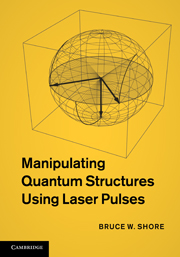Book contents
- Frontmatter
- Contents
- Preface
- Acknowledgments
- 1 Introduction
- 2 Atoms as structured particles
- 3 Radiation
- 4 The laser–atom interaction
- 5 Picturing quantum structure and changes
- 6 Incoherence: Rate equations
- 7 Coherence: The Schrödinger equation
- 8 Two-state coherent excitation
- 9 Weak pulse: Perturbation theory
- 10 The vector model
- 11 Sequential pulses
- 12 Degeneracy
- 13 Three states
- 14 Raman processes
- 15 Multilevel excitation
- 16 Averages and the statistical matrix (density matrix)
- 17 Systems with parts
- 18 Preparing superpositions
- 19 Measuring superpositions
- 20 Overall phase; interferometry and cyclic dynamics
- 21 Atoms affecting fields
- 22 Atoms in cavities
- 23 Control and optimization
- Appendix A Angular momentum
- Appendix B The multipole interaction
- Appendix C Classical radiation
- Appendix D Quantized radiation
- Appendix E Adiabatic states
- Appendix F Dark states; the Morris–Shore transformation
- Appendix G Near-periodic excitation; Floquet theory
- Appendix H Transitions; spectroscopic parameters
- References
- Index
- Frontmatter
- Contents
- Preface
- Acknowledgments
- 1 Introduction
- 2 Atoms as structured particles
- 3 Radiation
- 4 The laser–atom interaction
- 5 Picturing quantum structure and changes
- 6 Incoherence: Rate equations
- 7 Coherence: The Schrödinger equation
- 8 Two-state coherent excitation
- 9 Weak pulse: Perturbation theory
- 10 The vector model
- 11 Sequential pulses
- 12 Degeneracy
- 13 Three states
- 14 Raman processes
- 15 Multilevel excitation
- 16 Averages and the statistical matrix (density matrix)
- 17 Systems with parts
- 18 Preparing superpositions
- 19 Measuring superpositions
- 20 Overall phase; interferometry and cyclic dynamics
- 21 Atoms affecting fields
- 22 Atoms in cavities
- 23 Control and optimization
- Appendix A Angular momentum
- Appendix B The multipole interaction
- Appendix C Classical radiation
- Appendix D Quantized radiation
- Appendix E Adiabatic states
- Appendix F Dark states; the Morris–Shore transformation
- Appendix G Near-periodic excitation; Floquet theory
- Appendix H Transitions; spectroscopic parameters
- References
- Index
Summary
Manipulation of the internal structure of atoms and molecules – altering the quantum states of submicroscopic systems – makes an increasingly significant contribution to contemporary technology, as electronic circuits continue to shrink in size and new opportunities appear for applying abstract quantum theory to the creation of practical devices. The structural changes range from simple perturbative distortions of the electronic charge distribution to complete transformation into an excited energy state or the creation of superposition states whose properties cannot be fully described without quantum theory.
This monograph discusses ways of inducing such changes, primarily (but not only) with pulses of laser light, and ways of picturing the changes with the aid of suitable mathematical tools. Aiming at a level suitable for advanced undergraduates or researchers it explains the basic principles that underly the quantum engineering of devices used for such applications as coherent atomic excitation and quantum information processing.
Presupposing some familiarity with quantum mechanics, it first introduces notions of atoms (or other localized quantum systems) and quantum states, and of radiation (specifically laser pulses), defining thereby the essential observable quantities with which theory must deal. It presents the constructs – probabilities, probability amplitudes, wavefunctions, and statevectors – that serve as variables for the mathematics. It then discusses the differential equations that describe laser-induced changes to atomic structure. It contrasts the pre-laser incoherent absorption of energy, governed by rate equations, with the coherent regime of laser-induced changes, governed by the time-dependent Schrödinger equation that is the foundation for all descriptions of quantum-mechanical changes.
- Type
- Chapter
- Information
- Manipulating Quantum Structures Using Laser Pulses , pp. xi - xiiPublisher: Cambridge University PressPrint publication year: 2011
- 1
- Cited by

